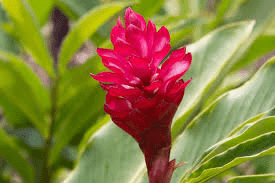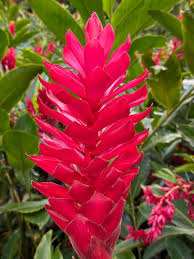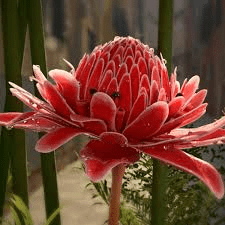Ginger flowers, the blossoms of the ginger plant (Zingiber officinale), are an often overlooked but fascinating part of this versatile plant. These flowers, which emerge from the base of the plant, are not only visually striking but also hold potential culinary and medicinal uses. Understanding the characteristics and uses of ginger flowers can provide a more comprehensive appreciation of the ginger plant.
Ginger flowers are typically cone-shaped and can vary in color, including shades of white, yellow, red, and pink. The blossoms are surrounded by bracts, which are modified leaves that protect the flowers and add to their ornamental appeal. The flowers themselves are relatively small and delicate, often with a tubular shape and a pleasant fragrance. The exact appearance of ginger flowers can vary depending on the specific variety of ginger being grown.
In culinary contexts, ginger flowers are used in a variety of ways, particularly in Asian cuisines. The flowers have a mild, slightly sweet flavor with a hint of ginger, making them a unique and exotic ingredient. They can be used fresh in salads, where their delicate flavor and attractive appearance add both taste and visual appeal. In Thai cuisine, ginger flowers are sometimes used in soups and curries, where they impart a subtle flavor and enhance the overall presentation of the dish.
Additionally, ginger flowers can be pickled or used as a garnish for various dishes, adding a touch of elegance and a mild gingery flavor. The petals can be scattered over salads or desserts, providing a floral note that complements the other ingredients. Ginger flowers can also be used to infuse beverages, such as teas and cocktails, with their gentle aroma and flavor.
Medicinally, ginger flowers share some of the beneficial properties of the ginger rhizome, although they are generally less potent. They contain antioxidants and other bioactive compounds that can contribute to overall health. In traditional medicine, ginger flowers have been used for their anti-inflammatory and digestive properties. Infusions or teas made from ginger flowers can help soothe digestive issues and reduce inflammation.
The cultivation of ginger flowers follows the same general principles as growing ginger for its rhizomes. The plant thrives in warm, humid environments with well-drained soil and partial shade. To encourage flowering, it is important to provide the plant with adequate nutrients and water. Ginger plants typically flower after about 10 months to a year of growth, and the flowers can be harvested once they have fully developed.
Ginger flowers can also serve an ornamental purpose in gardens and floral arrangements. Their vibrant colors and unique shapes make them an attractive addition to tropical gardens and floral displays. Growing ginger plants specifically for their flowers can add a decorative element to the garden while also providing a source of culinary and medicinal ingredients.
When harvesting ginger flowers, it is best to do so in the morning when they are freshest. The flowers should be used soon after harvesting to retain their flavor and aroma. If necessary, they can be stored in the refrigerator for a short period, although their delicate nature means they are best used fresh.
Ginger flowers are a beautiful and valuable part of the ginger plant, offering both culinary and medicinal benefits. Their mild, floral flavor and attractive appearance make them a unique ingredient in various dishes, while their health-promoting properties add to their appeal. By incorporating ginger flowers into cooking and natural remedies, one can fully appreciate the versatility and beauty of the ginger plant.
The Economic Importance and Uses of Ginger Flowers

1. Medicinal Uses: Ginger flowers are used in traditional medicine to treat various ailments, such as inflammation, digestive issues, and respiratory problems. For example, ginger flower tea is known to soothe sore throats.
2. Culinary Uses: Ginger flowers are used in culinary dishes for their aromatic properties. In Southeast Asian cuisine, they are often added to soups and salads for flavor and garnish.
3. Essential Oils: Ginger flower essential oils are extracted for use in aromatherapy and perfumery. These oils are known for their calming and anti-inflammatory properties.
4. Ornamental Uses: Ginger flowers are popular in floral arrangements and landscaping due to their vibrant colors and exotic appearance.
5. Cosmetic Industry: Extracts from ginger flowers are used in skincare and haircare products for their antioxidant and anti-aging properties.
6. Tea Production: Ginger flowers are dried and used to make herbal teas, which are popular for their soothing and health-boosting benefits.
7. Fragrance Industry: The pleasant aroma of ginger flowers makes them a popular ingredient in perfumes and scented candles.
8. Natural Dye: The petals of ginger flowers can be used to create natural dyes for fabrics.
9. Traditional Ceremonies: In many cultures, ginger flowers are used in religious and traditional ceremonies as offerings or decorations.
10. Beverages: Extracts from ginger flowers are used in the production of beverages like ginger ale and ginger beer.
11. Health Supplements: Ginger flower extracts are included in health supplements for their immune-boosting and anti-inflammatory properties.
12. Livelihood for Farmers: Cultivating ginger flowers can provide a significant source of income for farmers in tropical regions.
13. Bioactive Compounds: Ginger flowers contain bioactive compounds that are researched for potential therapeutic applications.
14. Pest Repellent: The scent of ginger flowers can act as a natural pest repellent in gardens.
15. Flavor Enhancer: In culinary applications, ginger flowers are used as a natural flavor enhancer.
16. Cultural Symbolism: Ginger flowers often hold cultural significance and are symbols of health and prosperity in various traditions.
17. Anti-microbial Properties: The extracts from ginger flowers have anti-microbial properties and are used in natural preservatives.
18. Environmental Benefits: Growing ginger flowers can help with soil conservation and biodiversity, making them beneficial for the environment.
Read Also: The Most Lucrative between Production of Fish Fingerlings or Raising them to Table Size
The Products and By-products That Can Be Derived From Ginger Flowers

1. Essential Oil: Extracted through steam distillation, used in aromatherapy and perfumery.
2. Herbal Tea: Made by drying and infusing the flowers in hot water.
3. Skincare Products: Extracts used in lotions, creams, and serums for their anti-aging properties.
4. Haircare Products: Added to shampoos and conditioners to promote hair health.
5. Perfumes: The aromatic oils are blended into fragrances.
6. Scented Candles: Ginger flower oils are used to create fragrant candles.
7. Natural Dyes: Petals processed to produce dyes for textiles.
8. Food Flavorings: Extracts used to enhance the flavor of various dishes.
9. Health Supplements: Capsules and tablets containing ginger flower extracts for health benefits.
10. Beverages: Ingredients in drinks like ginger ale and herbal infusions.
11. Pest Repellents: Extracts formulated into natural insect repellents.
12. Decorative Items: Dried flowers used in potpourri and other decorative crafts.
13. Traditional Medicine: Extracts used in various medicinal preparations.
14. Cultural Artifacts: Used in making traditional decorations and ceremonial items.
15. Natural Preservatives: Compounds used in food preservation for their anti-microbial properties.
16. Aromatic Sachets: Dried flowers placed in sachets for scenting closets and drawers.
17. Eco-friendly Packaging: Using the fibrous parts of the flower for sustainable packaging materials.
Read Also: The Ultimate Step-by-Step Guide to Vegetable Gardening
Frequently Asked Questions (FAQ’s) About Ginger Flowers

1. What are ginger flowers?
Ginger flowers are the blossoms of the ginger plant, known for their aromatic and medicinal properties.
2. How are ginger flowers used in cooking?
Ginger flowers are used as a spice and flavoring in various dishes, especially in Southeast Asian cuisine.
3. Can ginger flowers be used in tea?
Yes, dried ginger flowers are commonly used to make herbal teas with health benefits.
4. Are ginger flowers used in traditional medicine?
Ginger flowers have been used in traditional medicine to treat ailments like inflammation and digestive issues.
5. What products can be made from ginger flower extracts?
Products include essential oils, skincare items, haircare products, and perfumes.
6. How are ginger flower essential oils extracted?
The oils are typically extracted through a process of steam distillation.
7. What are the cosmetic benefits of ginger flowers?
They are known for their antioxidant and anti-aging properties, making them popular in skincare and haircare products.
8. Can ginger flowers be used as a natural dye?
Yes, the petals can be processed to create natural dyes for fabrics.
9. What cultural significance do ginger flowers have?
In many cultures, ginger flowers symbolize health, prosperity, and are used in traditional ceremonies.
10. Are there any environmental benefits to growing ginger flowers?
Growing ginger flowers can help with soil conservation and biodiversity, benefiting the environment.
Read Also: What You Need to Know About Osteospermum

